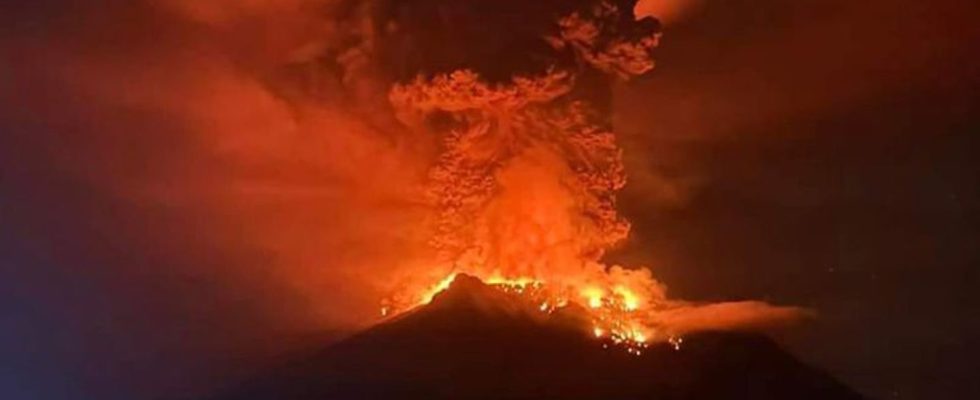alarm
Tsunami warning after violent volcanic eruption in Indonesia
Lava glows in the crater of Ruang volcano in the Sanguine Islands in Indonesia. photo
© Uncredited/BPBD Sitaro/AP/dpa
The Indonesian volcano Ruang has been spewing ash and rock for days. Parts of the Feuerberg could now fall into the sea. Thousands are fleeing a possible tsunami – it wouldn’t be the first time.
In Indonesia, authorities are warning of a possible eruption after several violent eruptions from the Ruang volcano Tsunami. The 725-meter-high Mountain of Fire in the Sangihe Archipelago north of Sulawesi has hurled clouds of ash and rock up to 3,000 meters high into the sky several times in the past few days. Because of the eruptions, parts of the volcanic island are in danger of falling into the sea. The highest alert level has now been issued. Thousands of people were brought to safety.
Tsunami warning
Volcanic eruptions have the potential to trigger tsunamis with devastating consequences, the Indonesian news agency Antara quoted a spokesman for the state Center for Meteorology, Climatology and Geophysics (BMKG). These would be caused by the collapse of the flanks of a volcano – or, in the worst case, the entire mountain. The result could be meter-high tidal waves.
In 1871, an eruption of Ruang triggered a tsunami with waves up to 25 meters high. Around 400 people died on the neighboring island of Tagulandang, five kilometers away.
The last time the volcano spewed a huge column of ash was in 2002, which moved westwards towards Borneo and Sumatra. “As far as the tsunami threat is concerned, we have learned from history,” said Heruningtyas Desi Purnamasari of the Center for Volcanology and Geological Hazards (PVMBG).
Exclusion zone of six kilometers
An exclusion zone was set up around the crater within a six-kilometer radius. Residents of the five-kilometer-long and four-kilometer-wide island were brought to safety, as were residents to the west and southwest of Tagulandang. The eruptions were preceded by several earthquakes since the beginning of April.
People near the coast should be particularly careful because glowing rock could fall into the sea at any time, authorities warned. In Tagulandang, residents have already been injured by falling ash and stones, said disaster management spokesman Abdul Muhari.
Local airport closed as a precaution
On Thursday, the airport in Manado, the provincial capital of North Sulawesi, was closed as a precautionary measure. Flights between the Malaysian capital Kuala Lumpur and the states of Sarawak and Sabah on the island of Borneo as well as other connections in the region were also canceled, airlines Malaysia Airlines, AirAsia and Batik Air said. The safety of passengers and crews is an absolute priority, it said.
The world’s largest island state, Indonesia, lies on the so-called Pacific Ring of Fire, the most geologically active zone on earth. Earthquakes and volcanic eruptions occur frequently along this belt. There are about 130 active volcanoes in Indonesia.
In December 2018, a flank of the Anak Krakatau volcano slipped into the Sunda Strait between the Indonesian islands of Java and Sumatra. Shortly afterwards, tidal waves flooded four coastal towns in the area. Around 430 people died and 14,000 were injured as a result of the tsunami.

